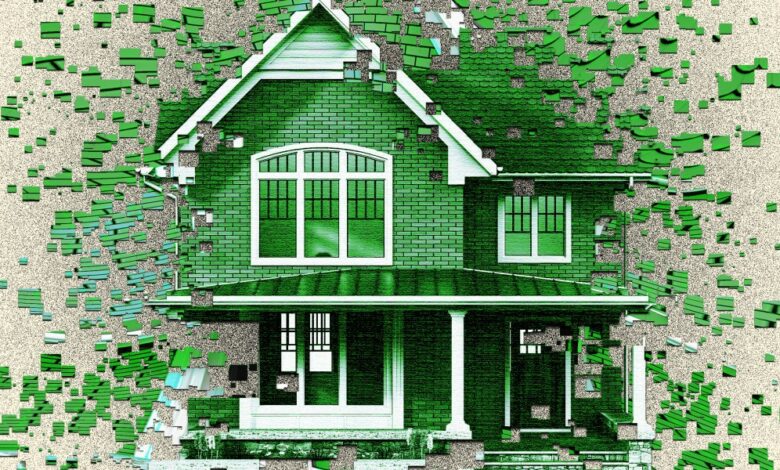The remote work subcity drove last year’s whopping $2 trillion-plus gain in housing market value, Redfin finds


The biggest asset class just got even bigger. The national housing market is now worth $47.5 trillion, after its value went up another $2.4 trillion over the last year, according to a preliminary Redfin analysis of more than 90 million homes as of December of last year. The answer, still, lies with the lure of remote work, and a very particular type of city is driving the increase.
“In percentage terms, the total value of U.S. homes increased 5.3% from a year earlier in December, the biggest increase in 11 months, and was up 13.3% ($5.6 trillion) from two years earlier,” the authors of the report, data journalist Lily Katz and head of the economics team Chen Zhao, wrote.
The largest increase came in the middle: More affordable metropolitan areas saw the largest jumps, while “pricey metros and pandemic boomtowns” either saw declines or little gains. For instance, the total value of homes in Newark, New Jersey, a gritty city just a stone’s throw from Manhattan, skyrocketed 12.8% over the last year to $359.6 billion, as of December; and in New Haven, Connecticut, a similarly gritty urban environment that is home to Yale University, the total value of homes jumped 11.9%. Camden, New Jersey; Charleston, South Carolina; and Elgin, Illinois, all saw their total value of homes rise more than 10%.
“Places like Newark and Camden are likely seeing home values jump in part because they’re attracting demand from people who are priced out of New York and can now work remotely,” the authors wrote, later adding that similar metropolitan areas are experiencing gains because “they’re affordable, and when mortgage rates and home prices are elevated, demand for affordable homes goes up.”
These bear a strong resemblance to what the World Bank and other experts call the “secondary city,” with populations ranging from 150,000 and up and serving as “secondary hubs” for larger metropolitan areas. Given that 2023 was the year when the remote work wars ended in a stalemate favoring a hybrid status quo of two to three days a week in the office, it makes sense that the boomtowns’ wings would be clipped and new growth centers would rise. Newark, outside New York, and Camden, outside Philadelphia, are clear winners in this new regime, each serving, to coin a phrase, as a sort of subcity to the stagnant dominant metro. (Colloquial use insists a subcity is a city that is geographically housed within another, like Beverly Hills inside Los Angeles.)
The losers
Meanwhile, Boise, Idaho; New York City; New Orleans; and Stockton, California all saw their over home value decline. Others, for instance, Philadelphia and Denver saw very small increases. It’s because these metropolitans are either already too expensive or “an influx of out-of-towners caused home values to skyrocket during the pandemic,” the authors said.
Moreover, the total value of homes in urban areas increased 3.6% year-over-year to roughly $10 trillion, as of December. In suburbs the value of homes rose 5.6% about $29 trillion. And in rural areas, the total value jumped 6.3% to $7.4 trillion, according to the analysis.
“The suburbs came back into vogue during the pandemic while cities fell out of favor—largely due to the shift to remote work and the housing affordability crisis,” Katz and Zhao wrote.
Still, home values in the suburbs are much higher than in urban and rural areas, “simply because most Americans live in the suburbs,” so there’s just much more property. In the suburbs there’s approximately 56 million homes. In rural and urban areas, there’s just over 20 million each.
But last year the housing market froze, and existing home sales plummeted to their lowest point in almost 30 years. So why are home prices still going up? The authors of the analysis broke it down to three reasons.
First, there isn’t enough for-sale inventory because homeowners who have locked in a low mortgage rate are holding on tight to their homes—knowing that if they sell, they’ll lose their low rate and end up with one that could more than double what it was. “Supply is even more constrained than demand, meaning buyers are competing for a limited pool of homes,” they wrote. “That’s propping up values for both homes that are already for sale and those that could hit the market in the future.”
Second, home values hit a low point roughly a year ago. By the end of 2022, the total value of homes across the country was close to hitting a trough because the market cooled so dramatically as a reaction to the mortgage rate shock. That’s also “part of the reason year-over-year growth at the end of 2023 was so large,” Katz and Zhao wrote.
The third and final reason is a bit more tricky and seems slightly counterintuitive. It’s common knowledge that the country has a housing crisis, but there are some places that are building homes, which technically contributed to the gain in total home value, according to Redfin.
Homeowners are ‘sitting pretty’
“America’s homeowners are sitting pretty,” Zhao said. “They’re holding a massive amount of housing wealth, despite lackluster demand from buyers, because home values skyrocketed during the pandemic and now a supply shortage is preventing those values from falling,”
She continued: “Prospective buyers aren’t as lucky. The combination of elevated mortgage rates, high home prices and a limited pool of homes for sale means homeownership is about as unaffordable as ever. One bright spot for buyers is that mortgage rates should start declining before the end of 2024.”
Toward the end of last year, several forecasters said that mortgage rates were going to fall, and to their point, they had fallen from their recent peak at above 8%. However, after dropping for several weeks, they began to inch up again, and are currently sitting at 7.10%. So this easing in affordability predicted by multiple institutions hasn’t really happened yet—but it is only the third month of the year. Still, the average home value jumped from $474,740 in December of 2022 to $495,183 in December of last year, according to Redfin.
Source link




